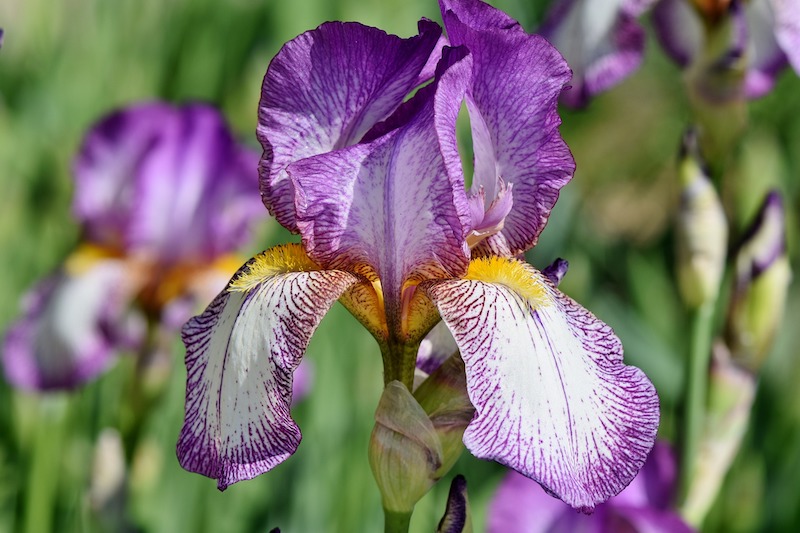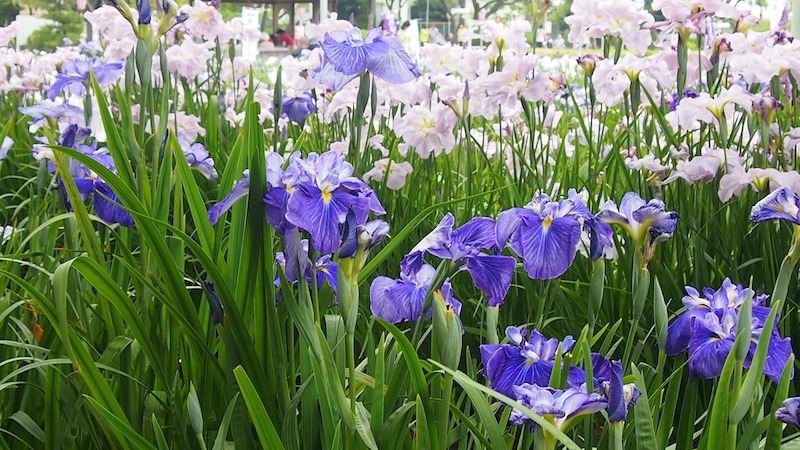Growing Iris
Iris is a genus of over 300 varieties of ornamental perennials. Within the genus, there are two main types of iris. The bulbous iris is generally a spring-blooming plant that is planted in the fall alongside other bulbs such as daffodils and tulips. The rhizomatous varieties of iris are a much larger group that encompasses both bearded and beardless types that are found native throughout Europe, Asia, North Africa, and the eastern half of the United States and Canada.
The color range of this ornamental is stunning and encompasses the whole rainbow, matching the Greek meaning of its name. A wide range of sizes are available to choose from, making the iris a suitable plant for just about any size garden from a traditional cottage garden to a postage stamp of a deck garden. Beginning gardeners in USDA growing zones 3-9 are guaranteed success with these low-maintenance and easy-to-care-for perennials.

Planting Iris
Iris grows and blooms best in full sun sites, no matter if they are bulb or rhizome variety. Ensure that the soil is free draining to protect the roots from sitting in water and becoming susceptible to root rot diseases. Soil that is enriched with organic compost and above 6.0 on the pH scale will provide all of the nutrients that iris needs to thrive for many years.
Irises that are grown from rhizomes will need to be planted slightly differently than the bulb types. Plant the rhizome so that it is exposed to full sun and sits with at least one-fourth of the rhizome above ground. Planting this type of iris too deep not only results in poor flowering, but increases the risk of the plant rotting at the base of the leaf fan.
Watering Iris
Iris also has a range of watering needs based on whether it is rhizomatous or bulbous. Generally, bulb-grown iris will need regular watering and can withstand cooler soil temperatures. Irises like Siberian or Japanese grow into large clumps and prefer to have moist soil all of the time. Japanese iris can even be grown in boggy areas near streams or ponds. The large and showy bearded iris prefers to have hotter and drier growing conditions and can even be incorporated into a water-wise planting plan due to their drought resistance at maturity.

Fertilizing Iris
Iris is easily fertilized with a slow-release granular fertilizer applied once a year. Top dress around the base of the plant in early spring as the new growth emerges. Use an all-purpose garden fertilizer with a balanced ratio of 5-5-5 NPK.
Pruning Iris
Deadheading is only needed at the end of the flowering period. Regular deadheading does not encourage more flowering, although cleanup at the end of the growing season will protect plants from pests and diseases that overwinter on the iris foliage. Cut back the leaves of bearded and bulb-type irises as they begin to die back soon after flowering. Siberian and Japanese irises will retain attractive green foliage until late fall and make a great space filler near other perennials that die back early in the summer.
Caring For Iris in Pots
Irises growing in containers are easy to care for and add a vertical element to mixed seasonal plantings. Ensure that the potting mix and container drain well year-round. Soggy soil will rot iris rhizomes and bulbs quickly and cause certain death. The pots should be positioned in full sun or part shade and given shelter from prevailing winds and storms during the winter months. Fertilize the containers once a month with a diluted liquid fertilizer with a balanced ratio of NPK.

Winter Care For Iris
Most varieties of iris are hardy to USDA zones 3 or 4 and can tolerate cold winters well with no special treatment. Cutting back the foliage after the first frost is recommended to keep pests and diseases from overwintering. A thick mulch of 3-4 inches of compost or finely shredded leaves will add insulation for the growing crown. Gardeners growing iris in warmer zones (7-9) may need to continue watering the plants during dry and warm autumns when the temperature remains above 45 degrees F.
Common Iris Care Questions
How Long Do Iris Live?
Iris rhizomes will come back and live year after year, with proper care. They should be divided and transplanted every few years to prevent overcrowding. That means, new iris, in new locations, for free!
What Is The Difference Between Bearded Iris and Siberian Iris?
Siberian Iris lacks the "beard" portion that the Bearded Iris has and the blooms are considerably smaller. Siberians Iris is hardier, and more adaptable, and maintains its foliage and their color throughout the season.
Do Iris Plants Need A Lot Of Sun?
Iris' will perform best, and bloom the most in full sun conditions, but can also do well in part shade.
How Do You Care For An Iris Plant?
Be sure to plant your iris in full sun and well-draining soil for them to perform at their best. Fertilizing isn't usually necessary as iris aren't heavy feeders, but a 4-4-2 can help them be stronger and healthier. Once they're well established, iris are fairly drought tolerant but love a slow, deep soaking every once in a while. Cut the Iris back in the fall after the foliage has died back naturally, doing so too soon will weaken the rhizome and future blooms. In colder climates, protect the rhizome from the cold with a good helping of mulch.
How Do You Care For Potted Iris Plants?
Containers with iris planted, definitely need to have good drainage to prevent the rhizomes from rotting. A soil mixture of bark, pumice, and peat moss is recommended while leaving the very top portion of the rhizome peeking out. Water only when the top two inches are dry when you poke your finger down into the soil.
Is Iris A High Maintenance Plant?
Iris' are extremely easy to grow, and require very little in the way of care.
Iris Isn't Blooming
Iris that don't bloom are sometimes caused by rhizomes or bulbs that are mushy, rotten, or malformed. Not enough sunlight can prevent blooming, at least 6 to 8 hours is best, and for longer-lasting blooms, shade during the hottest part of the day is beneficial.
Can I Grow Iris In Heavy Clay Soil?
Most Iris' prefer soil that is rich, fertile and drains well, but the Japanese Iris is a fantastic plant for heavy, clay soil that is consistently moist.
Have a question about Iris? Fill out the form below and we will try and get back to your question as soon as possible. We may even feature your question in this article to help other gardeners!
 |
Author Robbin Small - Published 4-18-2023 |
